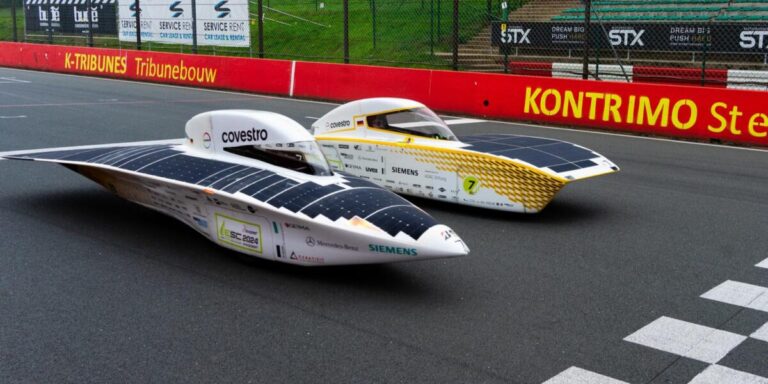Sonnenwagen Aachen, a student team from RWTH Aachen University in Germany, took second and third place at the iLumen European Solar Challenge 2024, sharing the podium with the Belgian KU Leuven team, which took first place.
The solar car team Sonnenwagen Aachen from Germany won two of the top three places during the iLumen European Solar Challenge 2024 in Belgium in September. The solar car Covestro Photon came second and the newer car, Covestro Adelie, third. The Belgian KU Leuven Innoptus Solar Team, which also won the Bridgestone World Solar Challenge 2023 in Australia, took first place.
The iLumen European Solar Challenge is a 24-hour endurance race that is held every two years in Belgium on a former Formula 1 circuit. It is open to student teams from Europe and beyond. This year there were 18 participants in all classes.
The Sonnewagen student team had two vehicles from the Challenger class. These are electric single-seater cars that weigh no more than 170 kg. The catamaran-shaped Covestro Photon completed 317 laps and the bullet-shaped Covestro Adelie completed 307 laps.
The design constraints are weight, aerodynamics and power, which influence every decision, from the shape of the shell to the solar panels, battery, inverter and materials, says team manager and mechanical engineering student from RWTH Aachen University, Leonie Brandt, who spent the last involved in solar car racing for three years.
The cars are equipped with interdigitated back contact solar cells from Maxeon Sunpower. The newer car, the Coverstro Adelie, had 567 half cells covering 96% of the available surface area.
“We chose half-cell because it allows us to optimize the available space, deal with curvatures and prevent losses due to shade,” Brandt said. pv magazine.
The 6 kWh battery features custom-designed modules and systems that fit precisely into the shell, while the cells are off-the-shelf. The inverter and Maximum Power Point Tracking (MPPT) technology come from commercial suppliers. Brandt noted that a 6 kWh battery used with a conventional electric vehicle motor would provide a range of 60 km, while their setup offers a range of 600 km.
The components include a Tritium WaveSculptor22 motor controller from Australian Prohelion and Dutch MPPT specialist Elmar Solar. “In the next edition we will develop our own inverter,” says Brandt.
The team is now working towards their entry into next year’s Bridgestone World Solar Challenge to meet the new racing requirements. “There are new rules and a guideline for much larger solar panels,” Brandt explains.
This content is copyrighted and may not be reused. If you would like to collaborate with us and reuse some of our content, please contact: editors@pv-magazine.com.
Popular content



